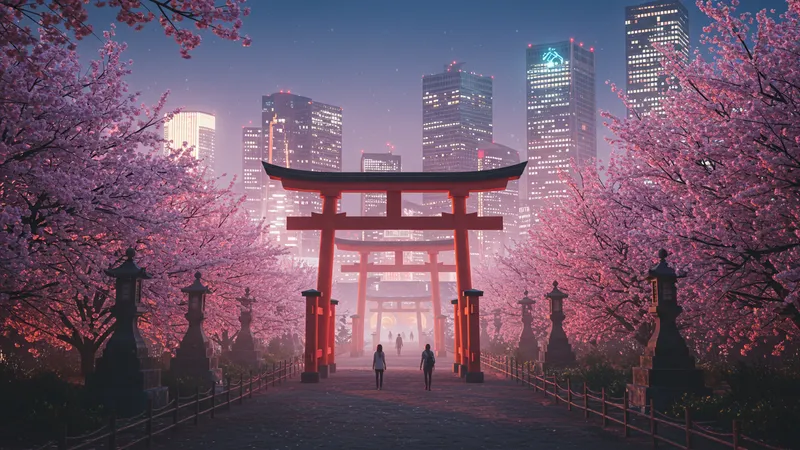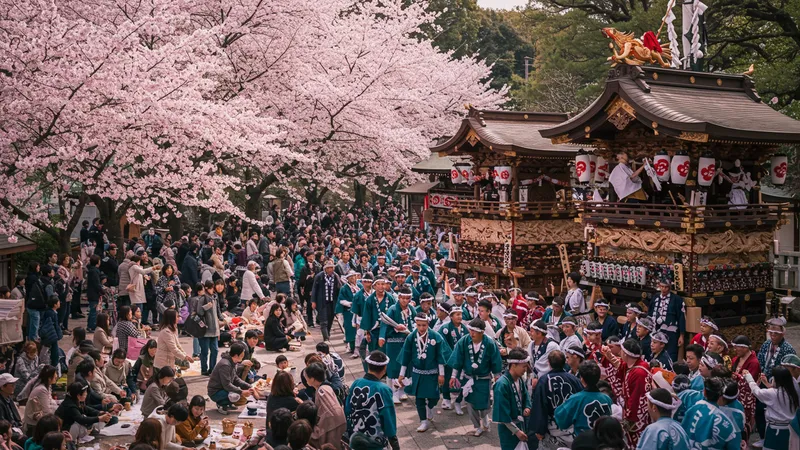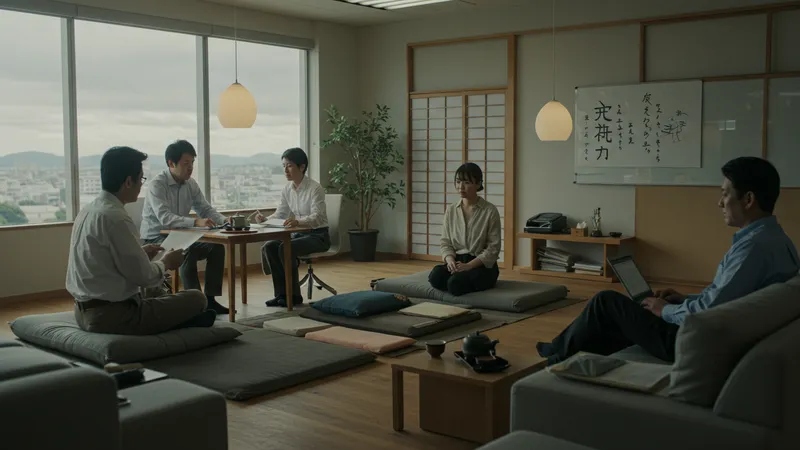Are you ready to uncover the travel secret that the world can't stop talking about? Japan is not just about cherry blossoms or sushi rolls. This enigmatic country will thrill even the most seasoned traveler. But here's the twist—its hidden wonders are more accessible and surprising than you think.
In an era where everyone craves unique experiences, Japan holds its ground as an unparalleled destination. The breathtaking blend of ancient traditions and futuristic innovations makes it a must-visit now more than ever. Uncover why this is the perfect time to book that ticket to the Land of the Rising Sun.

Japan is not just a shiny tech paradise; it is, in fact, teeming with quaint wisdom and hidden treasures. Sure, we all know its culinary prowess, but did you know Japan harbors a village where dolls outnumber people? Yes, Nagoro has become an eerie yet fascinating tourist fascination. But that's not even the wildest part...
Here's where things get even more intriguing: imagine bustling cities with bustling robot cafes or hushed forest paths alongside majestic shrines. You won't just visit Japan; you'll experience it in a way that's akin to living in a beautiful contradiction—a world where serenity meets chaos. What happens next shocked even the experts…
Tucked away from the neon lights are Japan’s lesser-known wonders that break the tourist cliches. For example, the serene Island of Naoshima, where art and architecture meet in an immersive experience. Unlike the busy streets of Tokyo, Naoshima invites you to slow down. Yet, every installation unfolds a narrative that's far beyond mere visuals. But there’s one more twist…

Local guides share tales of Tottori’s sand dunes, an unexpected spectacle akin to a tiny desert right in Japan. This is a playground for sandboarding enthusiasts and a rare scenery that baffles many tourists. Emerging just beyond the dunes are ancient ruins and folklore that echo history to a forgotten era. What you read next might change how you see this forever.
How about a dip in the warm therapeutic waters of an onsen in Beppu? While most tourists flock to overcrowded spots, Beppu offers a healing sanctuary often overlooked by guides. The natural hot springs here unleash a detoxifying flair seamlessly mingled with the untouched beauty of rustic Japan. Yet, unseen to many, an ancient ritual still thrives here...
Even within the daily hustle, Japan’s rural landscapes like the terraced paddies of Hoshitoge deliver picturesque beauty undisturbed by time. These sweeping vistas aren’t just backdrops for photos; they are cultural icons that offer a storytelling ballet through the seasons. But wait until you discover what makes these sights so exceptionally unique...
Japan, a nation woven with mythology and mystique, where urban legends are deeply enshrined in its cultural milieu. Take the story of Teke Teke, a spectral figure haunting railway stations. Despite scientific disbelief, locals often feel a shiver when setting foot on lonely platforms after dark. But is it all just folklore? Perhaps…

Then there’s the enigmatic Okiku Doll, believed to have hair that grows unnaturally. Kept in a shrine, it baffles visitors and has been the subject of numerous scrutiny. While science steps in to explain, believers argue that the doll is alive, rising questions of spirit and existence beyond conventional understanding. But what lies beneath this tale of horror?
Not to forget the tradition of Tsukimi, or moon viewing—an event laced with romance and mysticism. Thousands flock to celebrate under the full moon, adorned with poetry and picnics. Yet, there's an untold story behind this poetic imagery that binds the ceremony to ancient prayers for good harvests. Could it be mythical lore or cultural wisdom?
Embrace the enigma of Kappa, water creatures said to lurk in Japan’s rivers. Despite appearing in children’s books, these creatures teach morality and respect for nature. Scientists often relegate them to imaginary beings, yet their presence in culture reminds us of deeper ecological lessons. Is it legend, or a warning cloaked in mystery?
Dive into Akihabara, the electronic district that defies expectations. Here, technology and consumerism unite in a frenzy that feels like a glimpse into the future. From AI-driven humanoids to an overwhelming array of gadgets, it's a fascinating chaos. But there’s more to Akihabara than just tech brilliance…

Consider the bullet train or Shinkansen, reaching speeds up to 200 mph. Far more than mere transportation, it signifies Japan’s dedication to punctuality and innovation. This high-speed wonder has redefined travel, yet it harbors secrets of engineering feats that might surprise you with each ride. But why are these secrets rarely shared?
In robot cafes, enjoy drinks brought by mechanical waiters, blurring the line between novelty and necessity. Though tourists often snicker at the sight, residents see an evolution in hospitality driven by efficiency. But consider the implications—could this be the future norm or just a transient trend?
Moreover, Japan's futuristic marvel, the use of vending machines for practically everything, embodies convenience culture at its prime. From hot meals to retail goods within arm's reach, these machines symbolize efficiency. Yet, peeled back, they reveal social habits and economic factors unexpected by outsiders. But could these machines hold a secret edge over traditional businesses?
Japan’s festivals are vivid spectacles echoing the depth of tradition and community spirit. Hanami, or cherry blossom viewing, is more than pink petals; it's a celebration of ephemeral beauty. What you see are the crowds beneath the blossoms, but the true party happens in the heart of participants. Ready to learn the hidden layers of this festive spirit?

At Gion Matsuri in Kyoto, the ancient charisma rolls out with extravagant floats and fervent parades. Visitors marvel at the pageantry, yet underneath lies intricate rituals kept alive by generations. Only the deeply knowledgeable understand the festival's role in preserving cultural memory. But how did it survive modern evolution?
Nagara River's cormorant fishing reveals an ancient technique almost forgotten. Amid summer night settings, fishermen guided by fire illuminate one of Japan's hidden cultural gems. Tourists often see it as mere entertainment, unaware of its significance in ecological harmony and traditional lifestyle. But delve deeper, and you might discover an even grander purpose.
Even the exuberant Awa Dance Festival invites you to revel and dance to dizzying beats. What seems like a mere dance contest integrates spiritual overtones and acts of devotion. As footwork syncs with drumming, the modern audience taps into a layer of ancestral connection. But there's one more reason these festivals stay timeless...
You might assume Japanese cuisine starts and ends with sushi, but it's just scratching the surface. Discover the hearty comfort of a homemade bowl of miso soup, a dish that nourishes both body and soul during cold mornings. What isn't well known is its role in Japanese dietary balance.

Venture past the familiar with nattō, fermented soybeans, often met with mixed reactions. Its slimy texture and pungent aroma test even the bold eaters, yet it's a powerhouse of probiotics, energizing the immune system. This divisive dish carries controversies but offers nutritional promise challenging perceptions.
Whistle-stop through Japan's street food scene reveals culinary creativity bursting with flavor. Consider takoyaki, or octopus balls, sizzling away at food stalls. It delights and surprises simultaneously, igniting a crunchy, savory taste explosion. To a beginner, it might seem simpler than it is—a testament to Japan's culinary ingenuity.
Do not overlook the comforting, often-overlooked tempura, a fried harmony of textures. Beyond flavor lies a meticulous preparation that transforms common ingredients into art. Fried, yet remarkably light, tempura becomes a subject of intrigue when exploring Japanese cuisine’s secret art of cooking. But one undiscovery remains—for Japan’s cuisine holds another extraordinary element...
The powerful anime industry now boasts a multi-billion dollar global phenomenon, with studios like Studio Ghibli and creators such as Hayao Miyazaki influencing countless fans. Their storytelling magic creates worlds that transcend cultural boundaries and inspire audiences beyond imagination.

Adding to Japan's vibrant cultural mosaic, Manga captures complex narratives through vivid artistry. While conforming to social norms, these stories unravel rebellion and breakthrough characters. From 'Naruto' to 'Attack on Titan', they highlight Japan's capacity to export culture to uncharted territories.
Cosplay culture transcends regular hobbies, transforming passionate fans into living embodiments of favorite characters. Events like Comiket in Tokyo bring together devoted enthusiasts, not merely to display costumes but to engage in a shared act of creative expression. Yet, peel back the fabric, and you find a unique social dialogue.
Furthermore, J-pop captivates with its idol groups, dance moves, and a music genre that's fast becoming a hallmark. Catchy tunes by bands like Arashi or superstar Hikaru Utada highlight an evolution—a devotion to art reflected in its passionate following. But yet again, there’s more to this spectacle than meets the eye...
Zen teachings provide a peaceful counterpoint to modern life's chaos, offering calming practices. Japanese gardens, for example, create harmony through meticulously orchestrated landscapes, where every stone and water flow tells a story of tranquility deserving appreciation.

Kintsugi, the art of repairing broken pottery with gold, transforms perceived imperfections into beauty. A compelling metaphor for resilience and transformation, Kintsugi is as much philosophy as it is art, giving purpose and meaningfulness to past experiences.
Ikigai, or 'reason for being', connects life passions and daily routines. It's a vibrant study of purpose deeply rooted in Japanese culture. Unlike the West's perception of success, Ikigai inspires a balance that captures life's genuine essence and fulfillment.
Simplicity is woven into daily rituals, revealed in the tea ceremony, a practice of patience and appreciation. Its detailed sequence mirrors everyday mindfulness, extending profound wisdom to those willing to embrace its message. But when you uncover Zen’s full impact—the revelation can be truly transformative...
While Japan often shines as a beacon of cultural progress, behind this veneer are age-old gender expectations still affecting the workforce. Women, despite progressive strides, endure challenges as they navigate a traditionally male-dominated society. But recent trends may signal an unexpected shift.

An increasing number of women in leadership roles provides a fresh narrative challenging societal norms. Yet, their ascent faces hurdles unseen by the public, layered with expectations of traditional roles. Will the new generation of empowered voices redefine Japan’s future?
The concept of parasaito shinguru, or 'parasite singles', introduces a unique socio-economic angle. Young Japanese choose to live at home longer, trading independence for economic shelter. It’s a phenomenon breaching traditionalist expectations, signaling a societal transition as marriage and family structures evolve.
But, with 'herbivore men' opting for non-aggressive, domesticated lifestyles, a cultural shift is evident. These men defy stereotypes, eschewing traditional roles and altering gender dynamics; however, their emergence in modern discussions raises a compelling question—how will these roles reshape Japan’s cultural and economic framework?
The world is watching Japan’s aging demographic transformation closely. As one of the oldest populations globally, Japan faces agricultural challenges, creating social and economic ripples. Government strategies now seek innovative ways to tackle this growing concern.

Robotics and AI in elder care reflect the advancing intersection of technology and human services. While pragmatic, these solutions stir conversations about reliance on tech for care. The Japanese experiment pushes boundaries but unveils uncertainty regarding emotional connection.
A grave concern lies in the rural depopulation threatening extinction of entire villages. Community structures erode, prompting government initiatives like Hometown Tax to retain residents. The situation highlights a pivotal moment for rural revitalization amid dwindling youth involvement.
Yet, centenarians' stories bring a glimmer of hope, illustrating vitality caused by lifestyle factors defining longevity. These personal journeys counterbalance demographic struggles and shed light on cultural elements fostering long and rewarding lives. However, as new challenges emerge—how will Japan adapt to this evolving narrative?
Japan's environmental challenges met by groundbreaking solutions redefine sustainable living. With initiatives like the energy-conserving 'Cool Biz' campaign, businesses now encourage a more flexible dress code, cutting air conditioning use—a move yielding freshness and efficiency.

Tokyo leads urban nature integration, blending green spaces with metropolitan settings remarkably. Rooftop gardens and vertical forests not only beautify—tackling urban heat and pollution, setting a precedent for eco-friendly urban planning. What happens next could revolutionize urban living...
The island nation tackles oceanic pollution through innovative 'ocean cleaning' technologies. Using sustainable materials, engineers design eco-machines capable of collecting marine debris, with ecosystems as their priority. The momentum gained reflects a passionate commitment to ocean restoration.
Local government and industries strive for a zero-waste future, embodying ethical consumption and recycling practices. Towns like Kamikatsu spotlight minimalist waste management—heralded as a model for global sustainability. In defying conventional implications, Japan's eco-centric transformation uncovers an unexpected truth...
The shrinking workforce presents a thrilling paradox. While labor shortages press economic levers, ingenuity emerges in automation and skilled foreign labor integration. This complex landscape holds both adverse and groundbreaking potential.

Robotech offers answers where human resources falter, with robots undertaking tasks in factories across the nation, redefining industrial productivity. But the reliance on this technology also raises dilemmas about job displacement over future prospects.
With a declining birth rate, immigration provides a strategic lever boosting labor, particularly in sectors like construction and care. Yet, with immigration remain deeply entwined biases and cultural acceptance challenges unknown to many outside perspectives.
Yet, macroeconomic policies adapt ingeniously, pushing boundaries and exploring alternative revenue streams beyond traditional manufacturing. As Japan urbanizes its workforce modal, the economic narrative shifts—but where does this smallest stroke lead in redefining global influences?
Japan’s architectural identity morphs, championing sustainable design without losing its cultural integrity. Architectural marvels blend tradition with the unyielding modernity of today’s infrastructural needs in an aesthetic yet practical equilibrium.

Famed buildings like Asakusa Culture and Tourism Center embody a striking blend of simplicity and sophistication. Rei Street contrasts Tokyo’s skyline with landfill-dodging design ingenuity. Yet, these structures merely foreshadow tomorrow’s emerging techniques.
Minimalism bounds functionality through the Adronis aesthetic. Streamlined designs emphasize openness, drawing attention to empty spaces and coordinating the chaos reduction to enhance simplicity—a hidden simplification reflecting intricate wisdom.
Reimagining heritage, Kumamoto Castle unveils post-renovation. A cultural stronghold rebirthed under new disaster-resilient design, preserving identity while modernizing safety. This dynamic interplay exhibits lasting significance in architecture’s evolving dialogue, anticipating bold innovations within crafted balance.
Japan might be known for longstanding work ethics, but recent shifts unveil an undiscovered depth. Concepts like "karoshi" or overwork death whisper an urgent call for change, an elephant in the room that necessitates untangling ingrained labor cultures.

"Yūkan" propagates offering solace in structured relaxation, reimagining stress-coping frameworks aligning employee well-being and productivity. While placid approaches take shape, they unravel insufficient workplace paradigms defying conventional norms.
Technology’s deeper encroachment offers regenerative possibilities in remote work upheaval. Embracing flexibility opens functional spaces, rewriting communication codes and work evaluations sprawling across previously unventured terrain.
A subtle change in corporate evolution elucidates women scaling executive ladders, replacing organizational hierarchies with flatter, focused plates brewed toward inclusivity. This paradigm blend of change bridges traces of an entrenched hierarchy now ready to evolve beyond tradition.
Omotenashi’s artful devotion to hospitality extends the world over, from Japanese tea rooms to luxury hotels. It replicates excellence and mindfulness principles, dissolving alienations in favor of enduring connectedness.

Kyoto ryokans preserve time-honored ceremonies instilling immersive experiences—uniquely ornate gestures emerging as a token of sincerity driven by profound relational bonds. Beyond service, they encapsulate an essence transforming brief encounters into valued memories.
Tokyo’s eccentrically cultured henro, or hospitality services, transmit an unparalleled care layer admired globally. Architectural wonders reflect centuries-old wisdom positioned within girded relationships—a magical stillness inspiring reflective symbiosis.
From the ermine dignity at Edo’s fabled dining table to meticulous attention in regional inns, each exchange offers profound, personal connections that frame reality anew. Omotenashi heralds heartfelt connections, underpinning commercial beauty’s genuine intentional love.
Recognizing Japan’s immersive marvels invites a deeper conversation about its enriching narrative. Beyond symbolic experiences, each revelation holds tangible complexities mirroring national transformations. Unlocking these provides essential perspectives—critical initiatives for surviving the unfamiliar.
Feel compelled to explore? Let others embark on this dynamic Japanese odyssey—share the concealed allure awaiting discovery with every step. Let this be your catalyst for the ultimate travel escapade. Don’t keep this impeccable journey a secret; pass it onward.